In my world, fermenting is definitely an aspect of refining the flavor of fresh products. I love to imitate the aromatic landscapes of national cuisines with spices and herbs for my ferments, or I let myself be inspired and think up new seasoning combinations. Honoring traditions and origins are just as important to me as the taste experience.
If you haven't yet put the cuisines of the Caucasian regions on your plate, especially the flavors of Georgia, which I deeply appreciate, this ferment will give you a first taste of what you've been missing. Spices and fresh herbs play a central role: pepper, blue clover, ombalo, mint, tarragon, parsley, condari, basil, dill and coriander are the stars of the pots and plates.
Georgia, a mountainous country with access to the Black Sea, is one of the oldest settlement areas of mankind. Due to the diverse climatic zones and the resulting variety of cultivated products, a delicious and rich cuisine developed, which was considered the haute cuisine of Soviet cookery. Today it is appreciated by gourmets all over the world.
Fermented plums as sauce base
Tkemali or Tqemali (Georgian ტყემალი; tʼqʼɛmɑlɪ) is a popular Georgian sauce, sometimes called plum ketchup. Fermented plums are also the classic example of wild fermentation of fruit.
INGREDIENTS
- 580 gr. damson plums *
- 1 garlic clove
- 2 fresh red chillis
- some fresh mint leafs
- ½ tsp coriander seeds
- ½ tsp fennel seeds
- ¼ tsp fenugreek
- ½ tsp blue clover
- 2 allspice seeds
- 3% salt brine
- 1 tbsp honey
* that corresponds to about 20 damsons, weighed pitted. You can also use other plums, in Georgia it is common to eat both purple and green plum sauce. They should not be too ripe, though. If the fruit is very ripe, the ferment will tend to sour too much due to the higher fructose content.
The indicated quantities fit into a 0.75 liter jar.
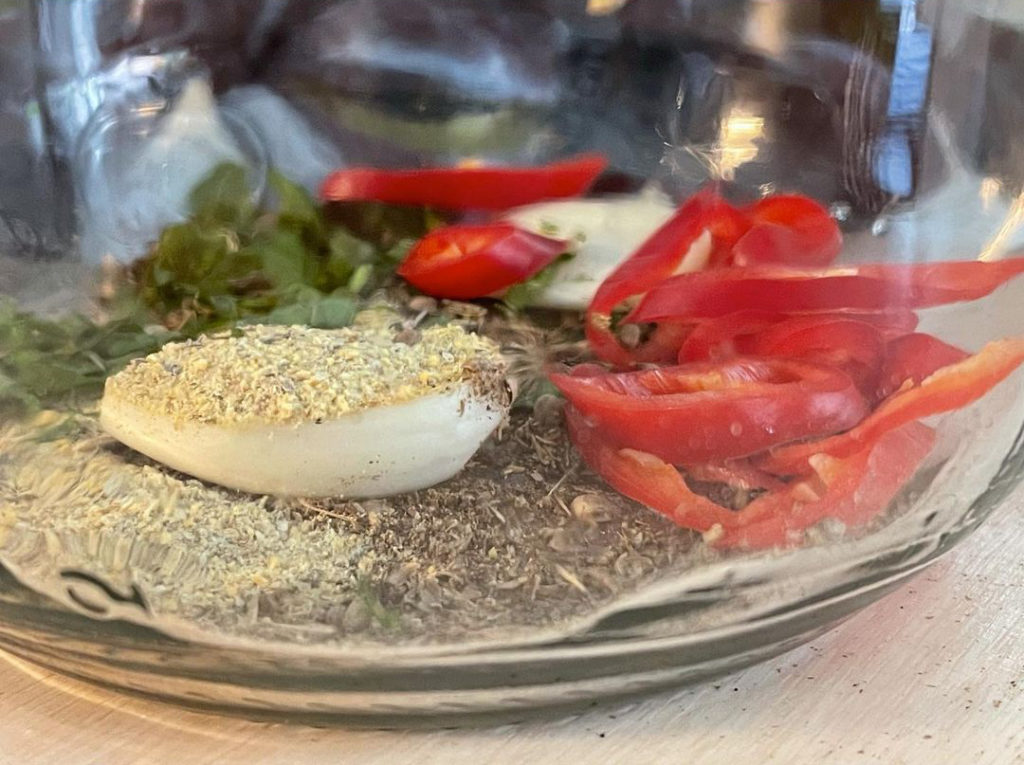
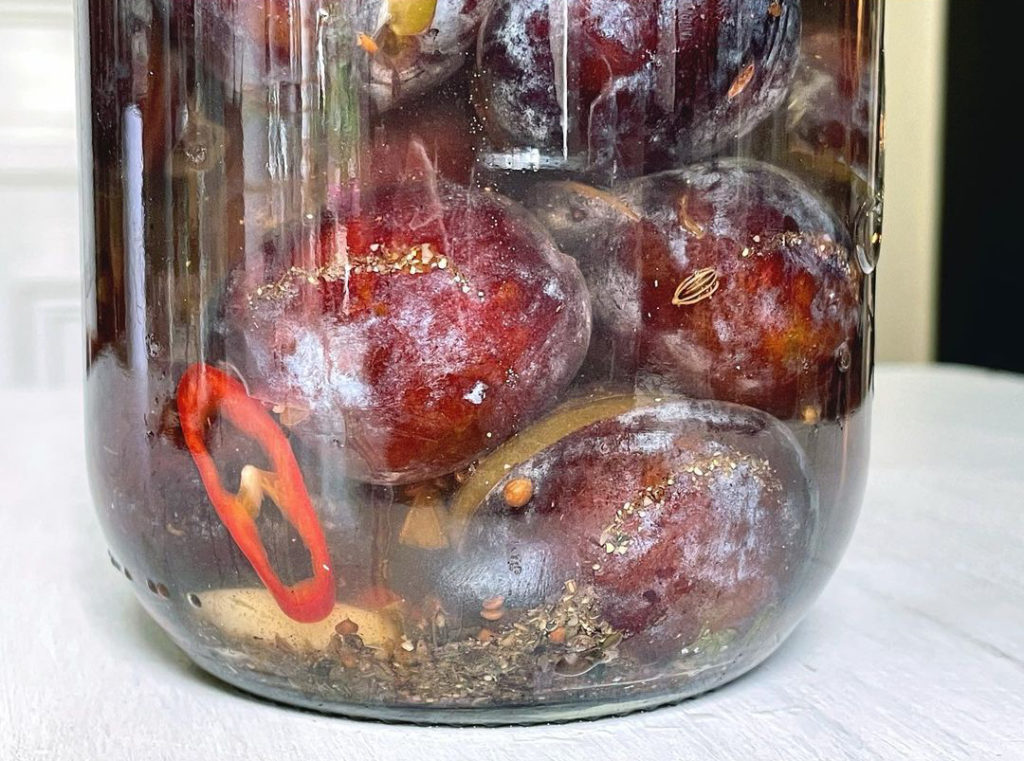
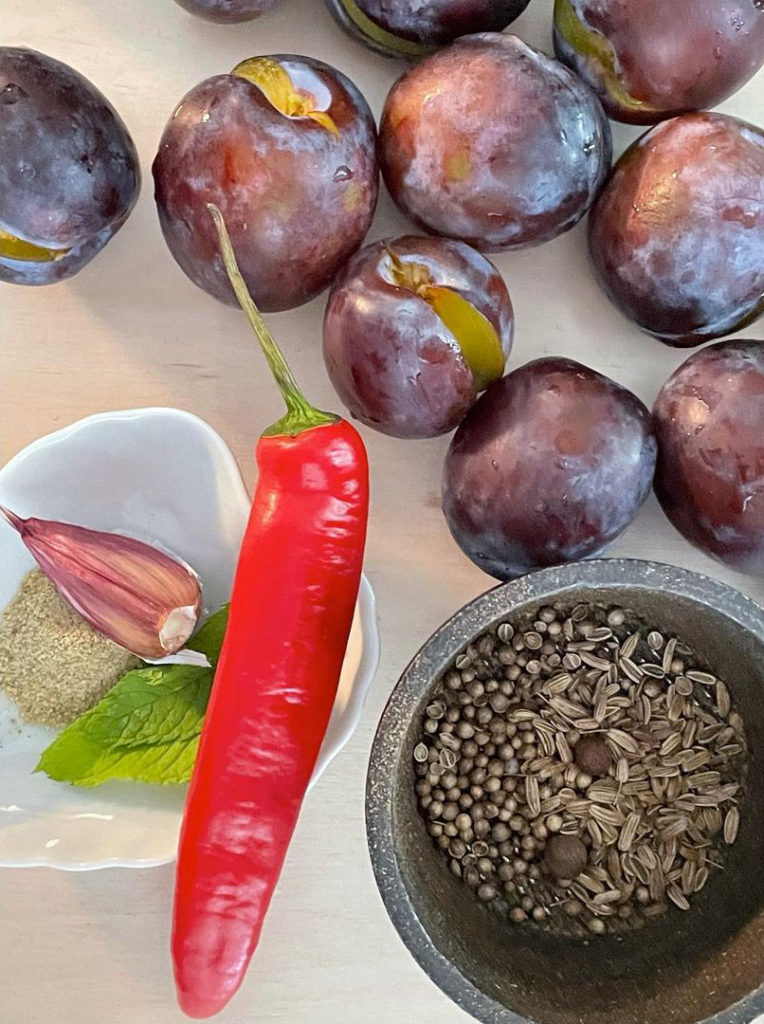
PREPARATION
Stone the plums, peel the garlic clove and coarsely grind the spices in a mortar. Cut the chili peppers in half and remove the cap. Make a brine with 300 ml of water and 9 grams of salt and dissolve the honey in it. Put the spices and garlic at the bottom of the jar, then put the pitted plums on top. Somewhere in the middle of the jar place the chili.
Weigh down with 1-2 glass lids from preserving jars or another suitable weight so the plums don't float and then pour the brine. If there too little brine to cover everything, just make some more out of water and salt. There is no need to add more honey. By the way, my brine calculator will be happy to calculate the grams for a 3% salinity with a variable amount of water for you.
Ferment plums for 2-3 weeks
Keep the plums shady, but warm, and let them ferment until the active phase is over. That is, the jar no longer fizzes and bubbles. This takes about 3 weeks. 18° - 22° C is the optimal temperature for this. This ferment can also be allowed to ferment at the warm end of the spectrum, in which case the desired, delicious acidity will form.
Boil down the fermented plums to make plum ketchup
Put the entire contents of the jar, i.e. fermented plums with brine and spices, into a saucepan and simmer for 20-30 minutes to soften the plums. It is important to use all the brine, otherwise the sauce will lack acidity and the taste will not be complete. The consistency may seem a bit runny, we'll take care of that in a later step.
INGREDIENTS II
- fresh (or dried) dill
- fresh cilantro
- fresh mint
- honey
- salt
- freshly ground black pepper
Coarsely chop the dill, coriander and mint. Adjust the seasoning to your liking with the herbs, salt, honey and black pepper. Each herb is optional, so if you don't like fresh cilantro, for example, just leave it out.
Puree, for this purpose a stand mixer or food processor is suitable, and then strain with the finest insert of the food mill or pass through a fine sieve. The resulting puree is slowly reduced over low heat to a creamy consistency and boiled down and portioned into jars or bottles.
Tkemali is traditionally served in Georgia as a cold sauce with potatoes or meat. I also love it a lot on cheese.
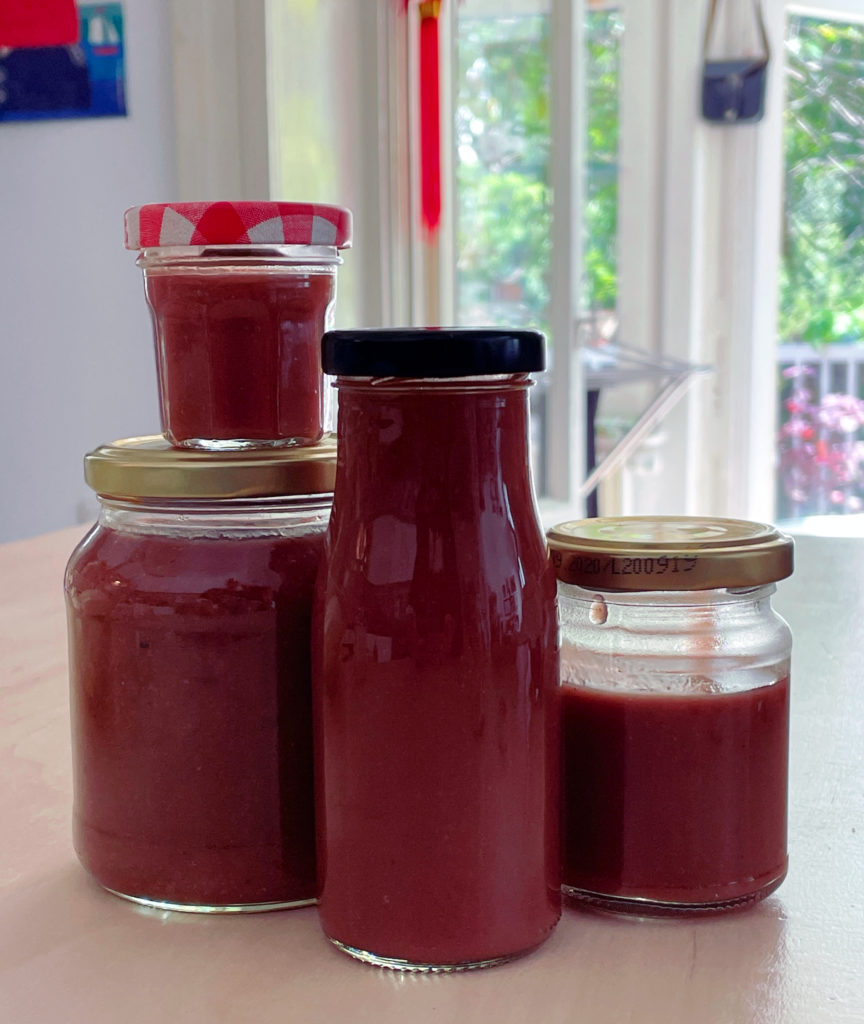
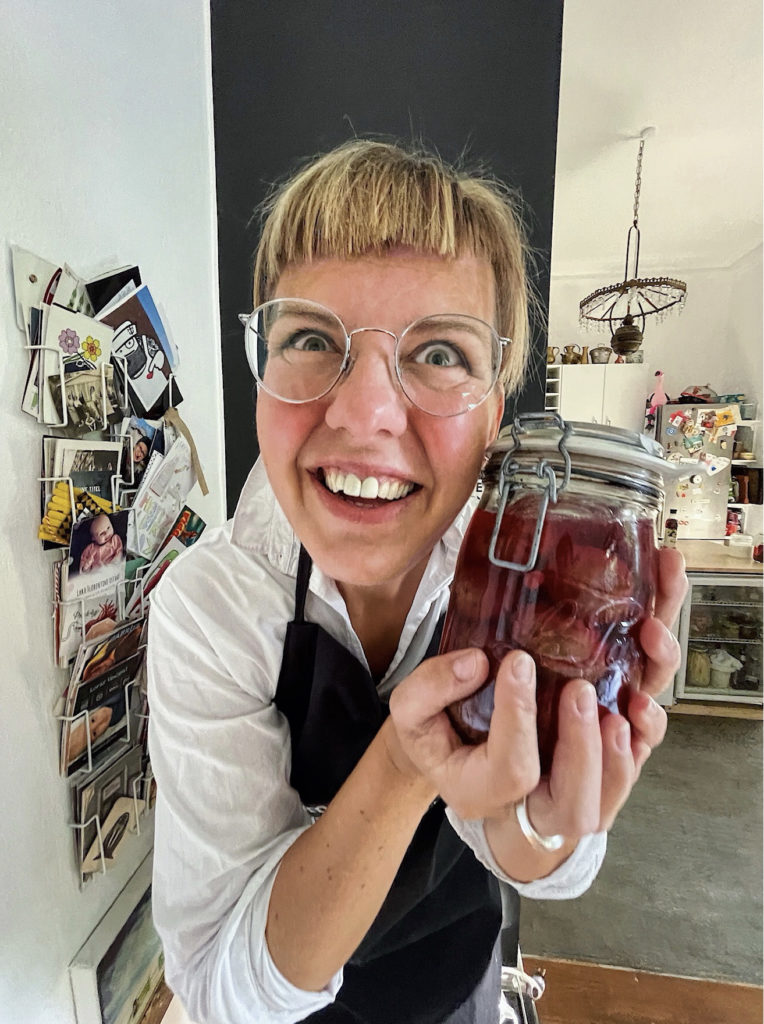
If I have won you over with the taste of this fermented plum sauce, you will love my sauerkraut with Georgian herbs as well!

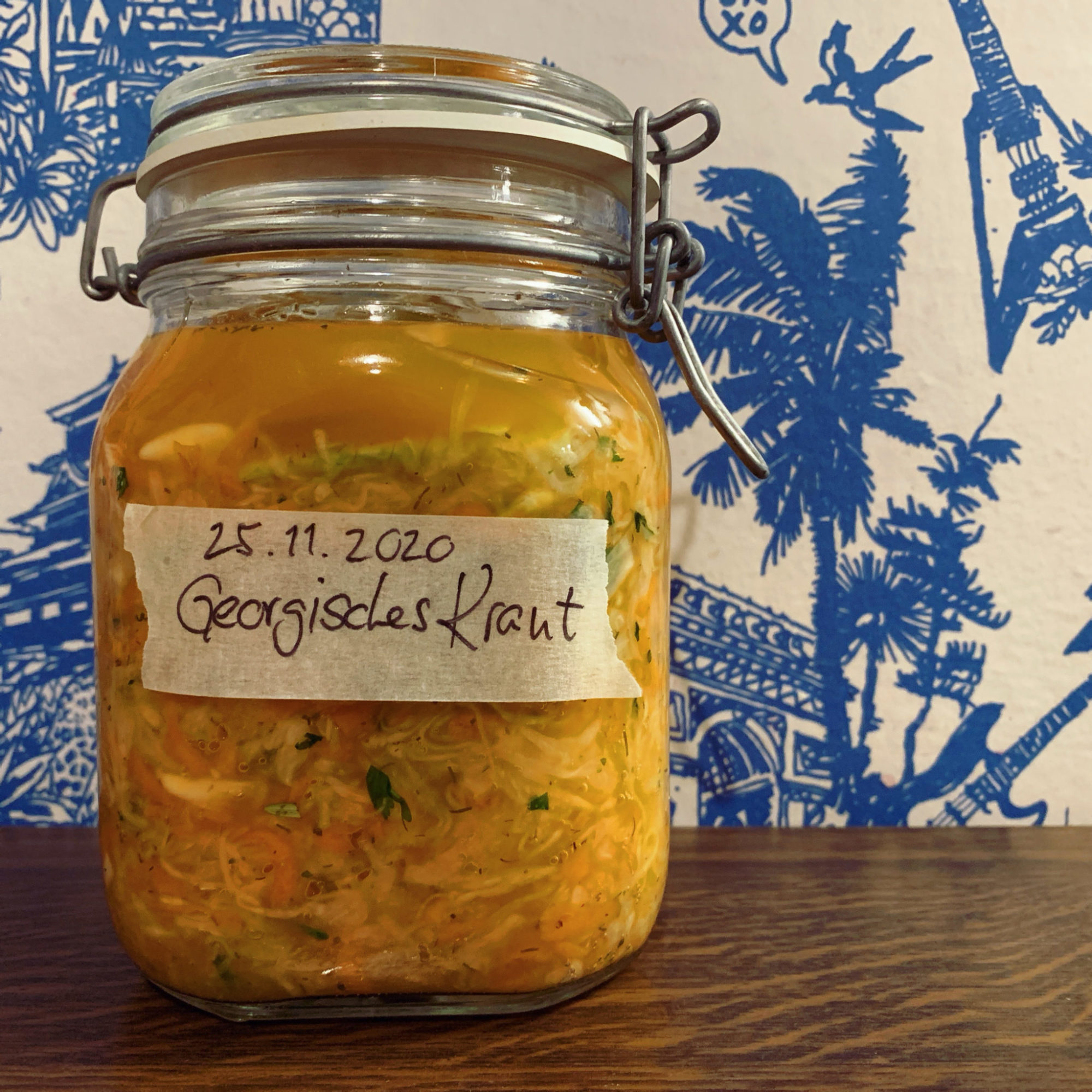
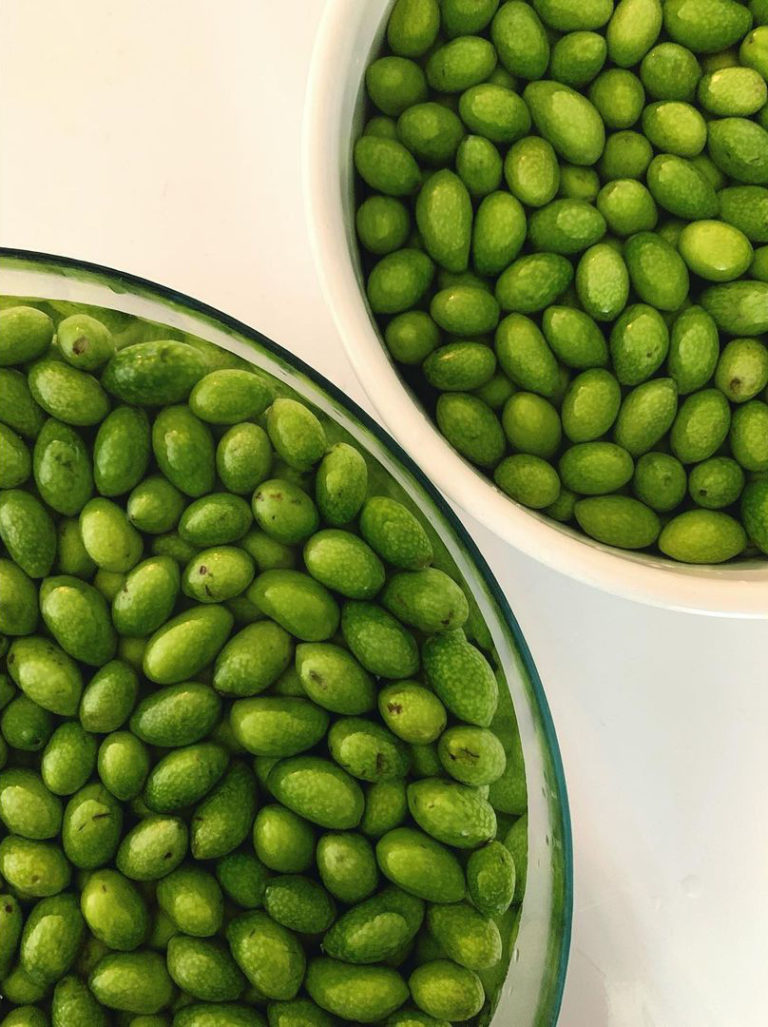
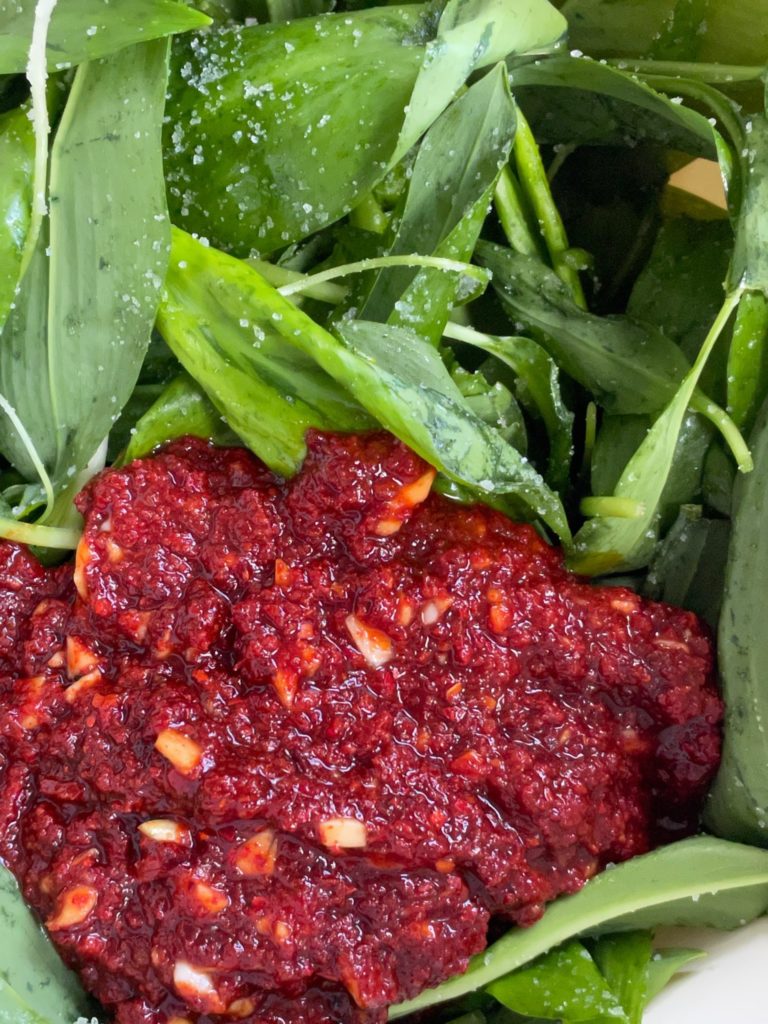
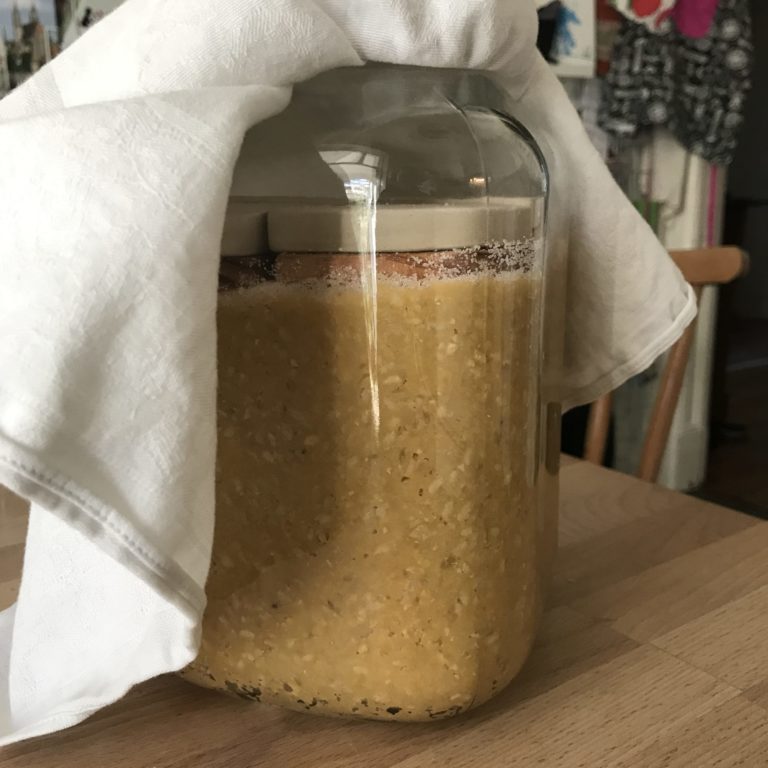
Hallo Katsu
Sehr schöne Site die Du hier hast. Ich fange gerade mit meinen ersten Gehversuchen mit Fermentieren an…..Wir haben sehr viele Gurken und eben habe ich noch Pflaumen erhalten die ich ebenfalls fermentieren möchte. Ich habe auf Deiner Site nichts gelesen, dass man das Bügelglas mit Dichtung alle 2 Tage wegen dem Druck des CO2 öffnen sollte. Ist das nötig oder überflüssig?
Danke und LG
Armin
Hej Armin,
vielen Dank! Du hast nichts darüber gelesen, weil es nicht nur überflüssig, sondern sogar kontraproduktiv ist. Das Ferment soll nämlich in einem anaeroben Milieu gären. Hier kannst Du nachlesen, welche Gefässe ich für geeignet halte – und warum:
https://fermentation.love/fermentation/die-grundausstattung-zum-fermentieren/#gefaesse_und_glaeser_zum_fermentieren
Gutes Gelingen!
Katsu
Hallo Katsu
Top, vielen Dank für die schnelle Antwort. Ich werde das nieeeee mehr machen, versprochen 😉
LG
Armin
PS: Melde mich wenn ich meine ersten Gurken naschen werde mit einem Update!
Freu mich drauf!
Hallo Katsu
Ich hab wieder einmal mei Pflaumenferment im Keller besucht… Ich hab da so das Gefühl, dass sich ein paar Gewürze einen Weg an der Barriere vorbei an die Oberfläche gefunden haben. Jedenfalls scheint es, dass es auf der Lake einen Schimmelbefall gegeben hat. Muss ich das Ferment wegwerfen? Es ist jetzt 2 Wochen seit ich es angesetzt habe.
LG Armin
Hej Armin,
das ist nicht gut. Bei Schimmelbefall muss das Glas entsorgt werden. Jetzt gilt es herauszufinden, warum Schimmel entstehen konnte. Bei mir ist das, trotz der Kräuter, noch nicht passiert. Lies am besten nochmal meine Tips zur Füllhöhe und Gewichten, dann passiert das hoffentlich nicht nochmal. https://fermentation.love/fermentation/fermentation-faq/
Schade, aber im Idealfall kannst Du etwas daraus lernen.
Weiterhin viel Spaß beim Fermentieren,
Katsu
Hallo,
Du sagst den Deckel zwischen durch zu öffnen ist kontraproduktiv.
Aber läuft es denn nicht über oder wohin geht CO2 ab?
Leyla
Hej Leyla,
dazu kannst du gerne hier https://fermentation.love/fermentation/die-grundausstattung-zum-fermentieren/ weiterlesen.
Gutes Gelingen!
Katsu
Hast du schon mal versucht die Kräuter aus Schritt 2 mitzufermentieren ?
Ja, überzeugt mich aber nicht.
Hallo, kann man Ihre Rezepte auch als Buch kaufen?
LG Anna
Hej Anna,
im Moment gibt es meine Rezepte nur gesammelt auf diesen Webseiten.
Viele Grüße,
Katsu
Hi Katsu,
ich will mich an den georgischen Pflaumen versuchen. wie lange sind die etwa haltbar ? würde dann evtl. den 2. Schritt nur bei Bedarf machen…
lieben Gruß
Mazze
Hej Mazze,
haltbar sind sie recht lange, mindestens mehrere Monate, werden allerdings immer saurer. Das kann aber sogar lecker sein, und mit Zucker oder Honig kannst Du das Ferment im zweiten Schritt immer noch abschmecken.
Gutes Gelingen!
Katsu
Hast du schon mal versucht die Kräuter aus Schritt 2 mitzufermentieren ?
Hallo Katsu, ich bin auf dieses tolle Rezept gestossen und habe es mit wilden Pflaumen ausprobiert. Die Pflaumen habe ich nach deiner Anleitung für 2,5 Wochen fermentiert, sie sind nun ziemlich sauer geworden, das schmeckt mir aber. Die Früchte sind nun ziemlich matschig und sie prickeln leicht auf der Zunge. Ist das etwas normales bei fermeniertem Obst? Kann fermentiertes Obst/Gemüse zu vergoren sein (prickeln) oder ist es, solange es nicht schimmelt oder stark unangenehm riecht, immer gut?
Danke dir für deine Rücckmeldung! Grüsse, Ina
Hej Ina,
immer gut kann ich nicht sagen, das wäre fahrlässig. Aber das Prickeln ist normal, das ist das durch die Fermentation entstandene Kohlendioxid. Und auch weich werden ist Teil des Umwandlungsprozesses. Wenn es Dir gut schmeckt, hurrah! Dann ist es gelungen.
Vertrau Deinen Sinnen.
Katsu
Hallo katsu, ist mit bockshornklee die blätter oder Samen gemeint und darf das tkemali scharf sein oder nur pikant?
Grüße Philippe
Hej Philippe,
die Samen sind gemeint. Und wenn Du es scharf magst, mach es gerne scharf. Dieses Rezept wird eher pikant.
Gutes Gelingen!
Katsu
Super, danke für die Info dann geb ich Mal Gas😉
Grüsse Philippe
Hallo Katsu
Operation gelungen! Ich habe gestern meine am 09. September eingelegten Pflaumen zu Sauce verarbeitet (somit 17 Tage fermentiert). Zwar haben sich wieder ein paar Gewürze an die Oberfläche gemogelt, das war aber diesmal kein Problem. Die Pflaumen haben “roh” schon echt lecker geschmeckt und als Sauce (heute mit Kartoffeln) war es unübertroffen. Ich hab bei den Chili die Kerne rausgenommen vor dem pürieren, die Sauce ist aber dennoch ziemlich scharf. Einfach so, zur “Warnung” an Mitleser.
Ich habe noch ein zweites Glas Pflaumen das am fermentieren ist. Ich möchte das 3 Wochen fermentieren lassen und dann ohne zu kochen lagern. Soll/kann ich das im Kühlschrank tun um den Fermentationsprozess zu stoppen/verlangsamen?
Danke für die wertvollen Tips.
LG Armin
Hej Armin,
klasse, dass Dir meine Tkemali-Sauce so gut schmeckt. Wenn Du Platz im Kühlschrank hast, ist das auf jeden Fall ein sehr geeigneter Ort, um das Ferment zu lagern. Die Fermentation wird in der Kälte fast komplett ausgebremst.
Gutes Gelingen!
Katsu
Liebe Katsu,
Inspiriert von deinem Pflaumen Thema (Danke!) habe ich Anfangs Juni Erik Pflaumen vom Türkenladen in Salzlacke mit Knoblauch eingelegt und heute probiert. Ich kann sie als Oliven Ersatz besets empfehlen. Sie sind salzig, säuerlich, das Knoblauch Arome ist angenehm vorhanden und die Konsistenz entspricht ebenfalls grünen Oliven.
Nächstes Jahr gebe ich noch ganz wenig Zitronen oder Orangen Schale und sehr wenig Bohnenkraut oder Thymian mit ins Glas.
Hej Barbara,
das ist ja schön, dass aus meinem Rezept ein neues Ferment geworden ist. Und Zitrusschale klingt total gut!
Gutes Gelingen,
Katsu
Hi.
Warum sollte man die Chili mittig im Glas unterbringen? Was wäre anders, wenn sie ganz unten geschichtet wäre?
Liebe Grüße
Hej Vans,
weil sich der Geschmack und die Schärfe dann gut im ganzen Glas verteilen. Wenn du sie unten reinpackst, kommt oben eventuell nüscht an.
Gutes Gelingen!
Katsu
Hallo Katsu,
Tolle Seite mit super Ideen ,wo jeder sich dran trauen kann .
Fermentierte Pflaumen sind ja momentan auch aus einem anderen Grund sehr gefragt :
Es soll bei Verstopfung helfen .
Ich Frage nicht nach gesundheitlichen Tipps sondern nur nach deiner Erfahrung.
Könntest du so einen Effekt bei dir feststellen?
Danke
Hej Leyla,
ich kann keinen anderen Effekt, als bei allen anderen Fermenten feststellen. Aber meine Oma hat bei Verstopfung eingeweichte Trockenpflaumen gegessen 🙂
Viel Erfolg beim Ausprobieren!
Katsu
Liebe Katsu
Mein Feigenbaum produziert so viele Früchte, dass ich mir überlegt habe, ob Feigen nicht auch mit Honig fermentiert werden könnten.
Hast Du entsprechende Erfahrungen?
Ich freue mich auf Deine Antwort!
Hej Samuel, ich habe es etwas anders gemacht, Feigen mit Honig nach 3 Tagen zu einem milchsauren Ferment gegeben. Das war super! Viel beim Experimentieren, Katsu